datetime:2023/09/12 14:16
author:nzb
该项目来源于大佬小鱼的动手学ROS2
1.使用g++编译ROS2节点
1.动态链接库
动态链接库介绍
引用文章:
程序编译一般需要经预处理、编译、汇编和链接几个步骤。在实际应用中,有些公共代码需要反复使用,就把这些代码编译成为“库”文件。在链接步骤中,链接器将从库文件取得所需的代码,复制到生成的可执行文件中,这种库称为静态(链接)库,其特点是可执行文件中包含了库代码的一份完整拷贝,缺点是被多次使用就会多份冗余拷贝。还有一种库,就是程序在开始运行后调用库函数时才被载入,这种库独立于现有的程序,其本身不可执行,但包含着程序需要调用的一些函数,这种库称为动态(链接)库(Dynamic Link Library)。
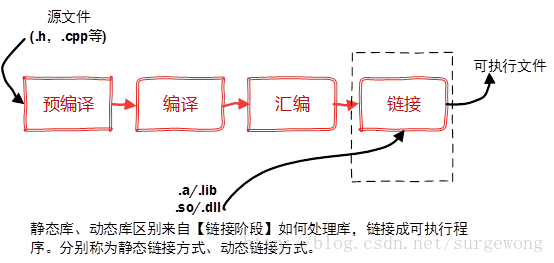
在widows平台下,静态链接库是.lib文件,动态库文件是.dll文件。在linux平台下,静态链接库是.a文件,动态链接库是.so文件。
2. 用g++编译ROS2的C++节点
2.1 编写节点
编写一个ROS2的C++节点非常简单,只需三行代码即可完成。
打开终端,创建chapt2/basic目录,用VSCODE打开d2lros2目录。
mkdir -p d2lros2/chapt2/basic/
code d2lros2
接着在左侧chapt2上新建first_ros2_node.cpp,然后在first_ros2_node.cpp中输入下面的代码。
// 包含rclcpp头文件,如果Vscode显示红色的波浪线也没关系
// 我们只是把VsCode当记事本而已,谁会在意记事本对代码的看法呢,不是吗?
#include "rclcpp/rclcpp.hpp"
int main(int argc, char **argv)
{
// 调用rclcpp的初始化函数
rclcpp::init(argc, argv);
// 调用rclcpp的循环运行我们创建的first_node节点
rclcpp::spin(std::make_shared<rclcpp::Node>("first_node"));
return 0;
}
2.2 编译
接着我们使用g++来编译first_ros2_node节点。正常的话一定会报错。
g++ first_ros2_node.cpp
报错内容如下:
root@490925f19143:~/d2lros2/d2lros2/chapt2/basic# g++ first_ros2_node.cpp
first_ros2_node.cpp:3:10: fatal error: rclcpp/rclcpp.hpp: No such file or directory
3 | #include "rclcpp/rclcpp.hpp"
| ^~~~~~~~~~~~~~~~~~~
compilation terminated.
一定要记住这个错误No such file or directory,这将是你接下来机器人学习工作生涯中最常见的错误之一。
接着来说说错误原因和解决方案。
原因我们在代码里包含了"rclcpp/rclcpp.hpp"头文件,但是g++找不到这个头文件,解决方法就是告诉g++这个头文件的目录。
首先我们要找到这个头文件在哪里,这个头文件是ROS2的客户端库,其地址肯定在ROS2的安装目录下,即/opt/ros/humble/include/rclcpp。
cd /opt/ros/humble/include/rclcpp
ls rclcpp/* | grep rclcpp.h
ls指令列出命令 | grep rclcpp.h 是对列出的结果进行过滤,只显示包含
rclcpp.h的行。
使用上面的指令,可以看到这个文件确实在这里。

接着我们可以用-I(大写i)来为g++指定这个目录,然后再次运行,你会发现依然报错
g++ first_ros2_node.cpp -I /opt/ros/humble/include/rclcpp/
报错如下
root@490925f19143:~/d2lros2/d2lros2/chapt2/basic# g++ first_ros2_node.cpp -I/opt/ros/humble/include/rclcpp/
In file included from /opt/ros/humble/include/rclcpp/rclcpp/executors/multi_threaded_executor.hpp:25,
from /opt/ros/humble/include/rclcpp/rclcpp/executors.hpp:21,
from /opt/ros/humble/include/rclcpp/rclcpp/rclcpp.hpp:155,
from first_ros2_node.cpp:3:
/opt/ros/humble/include/rclcpp/rclcpp/executor.hpp:30:10: fatal error: rcl/guard_condition.h: No such file or directory
30 | #include "rcl/guard_condition.h"
| ^~~~~~~~~~~~~~~~~~~~~~~
compilation terminated.
虽然错误有些不一样,但是核心的文件都是一样的,你应该都看到了No such file or directory
这个问题,并且错误信息还提示你了,在/opt/ros/humble/include/rclcpp/rclcpp/executors/multi_threaded_executor.hpp:25
这个位置,包含了rcl/guard_condition.h发现找不到这个头文件。
既然错误一样,那么解决方案也是相同的,rcl/guard_condition.h所在的路径是/opt/ros/humble/include/rcl/我们再次指定后运行。
g++ first_ros2_node.cpp -I /opt/ros/humble/include/rclcpp/ -I /opt/ros/humble/include/rcl/
你会发现还是相同错误,因为头文件的包含是类似于套娃形式的,一层层加下去,总有终点,直到最终这个样子
g++ first_ros2_node.cpp \
-I/opt/ros/humble/include/rclcpp/ \
-I /opt/ros/humble/include/rcl/ \
-I /opt/ros/humble/include/rcutils/ \
-I /opt/ros/humble/include/rmw \
-I /opt/ros/humble/include/rcl_yaml_param_parser/ \
-I /opt/ros/humble/include/rosidl_runtime_c \
-I /opt/ros/humble/include/rosidl_typesupport_interface \
-I /opt/ros/humble/include/rcpputils \
-I /opt/ros/humble/include/builtin_interfaces \
-I /opt/ros/humble/include/rosidl_runtime_cpp \
-I /opt/ros/humble/include/tracetools \
-I /opt/ros/humble/include/rcl_interfaces \
-I /opt/ros/humble/include/libstatistics_collector \
-I /opt/ros/humble/include/statistics_msgs
运行完上面这段代码,你会发现报的错误变了。
/usr/bin/ld: /tmp/ccoA8hho.o: in function `main':
first_ros2_node.cpp:(.text+0x37): undefined reference to `rcutils_get_default_allocator'
/usr/bin/ld: first_ros2_node.cpp:(.text+0x5c): undefined reference to `rclcpp::InitOptions::InitOptions(rcutils_allocator_s)'
/usr/bin/ld: first_ros2_node.cpp:(.text+0x7d): undefined reference to `rclcpp::init(int, char const* const*, rclcpp::InitOptions const&, rclcpp::SignalHandlerOptions)'
/usr/bin/ld: first_ros2_node.cpp:(.text+0x89): undefined reference to `rclcpp::InitOptions::~InitOptions()'
/usr/bin/ld: first_ros2_node.cpp:(.text+0xb1): undefined reference to `rclcpp::spin(std::shared_ptr<rclcpp::Node>)'
/usr/bin/ld: first_ros2_node.cpp:(.text+0xe9): undefined reference to `rclcpp::InitOptions::~InitOptions()'
/usr/bin/ld: /tmp/ccoA8hho.o: in function `void __gnu_cxx::new_allocator<rclcpp::Node>::construct<rclcpp::Node, char const (&) [11]>(rclcpp::Node*, char const (&) [11])':
first_ros2_node.cpp:(.text._ZN9__gnu_cxx13new_allocatorIN6rclcpp4NodeEE9constructIS2_JRA11_KcEEEvPT_DpOT0_[_ZN9__gnu_cxx13new_allocatorIN6rclcpp4NodeEE9constructIS2_JRA11_KcEEEvPT_DpOT0_]+0x86): undefined reference to `rcutils_get_default_allocator'
/usr/bin/ld: first_ros2_node.cpp:(.text._ZN9__gnu_cxx13new_allocatorIN6rclcpp4NodeEE9constructIS2_JRA11_KcEEEvPT_DpOT0_[_ZN9__gnu_cxx13new_allocatorIN6rclcpp4NodeEE9constructIS2_JRA11_KcEEEvPT_DpOT0_]+0xb7): undefined reference to `rclcpp::NodeOptions::NodeOptions(rcutils_allocator_s)'
/usr/bin/ld: first_ros2_node.cpp:(.text._ZN9__gnu_cxx13new_allocatorIN6rclcpp4NodeEE9constructIS2_JRA11_KcEEEvPT_DpOT0_[_ZN9__gnu_cxx13new_allocatorIN6rclcpp4NodeEE9constructIS2_JRA11_KcEEEvPT_DpOT0_]+0xe7): undefined reference to `rclcpp::Node::Node(std::__cxx11::basic_string<char, std::char_traits<char>, std::allocator<char> > const&, rclcpp::NodeOptions const&)'
collect2: error: ld returned 1 exit status
请记住上面错误中的undefined reference to xxxxx,这将是你接下来机器人学习工作生涯中另一个最常见的错误。
原因在于g++找不到库文件,解决方法就是我们帮助它定位到库文件的位置,并通过-L参数指定库目录,-l(小写L)指定库的名字。
ROS2相关的库的地址都在/opt/ros/humble/lib下,你可以使用下面的指定看到rclcpp的动态链接库。
ls /opt/ros/humble/lib | grep rclcpp
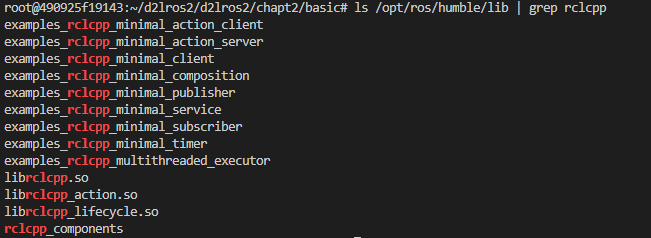
指定库目录和使用的库后的终极命令
g++ first_ros2_node.cpp \
-I/opt/ros/humble/include/rclcpp/ \
-I /opt/ros/humble/include/rcl/ \
-I /opt/ros/humble/include/rcutils/ \
-I /opt/ros/humble/include/rmw \
-I /opt/ros/humble/include/rcl_yaml_param_parser/ \
-I /opt/ros/humble/include/rosidl_runtime_c \
-I /opt/ros/humble/include/rosidl_typesupport_interface \
-I /opt/ros/humble/include/rcpputils \
-I /opt/ros/humble/include/builtin_interfaces \
-I /opt/ros/humble/include/rosidl_runtime_cpp \
-I /opt/ros/humble/include/tracetools \
-I /opt/ros/humble/include/rcl_interfaces \
-I /opt/ros/humble/include/libstatistics_collector \
-I /opt/ros/humble/include/statistics_msgs \
-L /opt/ros/humble/lib/ \
-lrclcpp -lrcutils
运行后,你会发现没有任何报错了,但是在当前目录下多出了一个a.out,这个就是我们将上面的代码编译和链接完库之后得出的可执行文件。
如果你觉得a.out不好听,可以在g++指定后添加
-o 名字,比如-o first_node
3. 运行节点
执行代码
./a.out
打开新的终端,使用ros2 node list查看正在运行的节点,是否有first_node。

2.使用make编译ROS2节点
有没有觉得用g++编译节点无比的麻烦,的确是这样子,为此先行者们发明了一个叫做make的批处理工具,我们可以将g++的指令写成脚本,就可以通过make自动的调用脚本完成操作。
1. 安装make
sudo apt install make
2. 编写Makefile
在d2lros2/d2lros2/chapt2/basic下新建Makefile,然后将上面的g++编译指令用下面的形式写到Makefile里。
build:
g++ first_ros2_node.cpp \
-I/opt/ros/humble/include/rclcpp/ \
-I /opt/ros/humble/include/rcl/ \
-I /opt/ros/humble/include/rcutils/ \
-I /opt/ros/humble/include/rmw \
-I /opt/ros/humble/include/rcl_yaml_param_parser/ \
-I /opt/ros/humble/include/rosidl_runtime_c \
-I /opt/ros/humble/include/rosidl_typesupport_interface \
-I /opt/ros/humble/include/rcpputils \
-I /opt/ros/humble/include/builtin_interfaces \
-I /opt/ros/humble/include/rosidl_runtime_cpp \
-I /opt/ros/humble/include/tracetools \
-I /opt/ros/humble/include/rcl_interfaces \
-I /opt/ros/humble/include/libstatistics_collector \
-I /opt/ros/humble/include/statistics_msgs \
-L /opt/ros/humble/lib/ \
-lrclcpp -lrcutils \
-o first_node
# 顺便加个clean指令,用来删掉first_node
clean:
rm first_node
3. 编译
在Makefile同级目录输入
make build
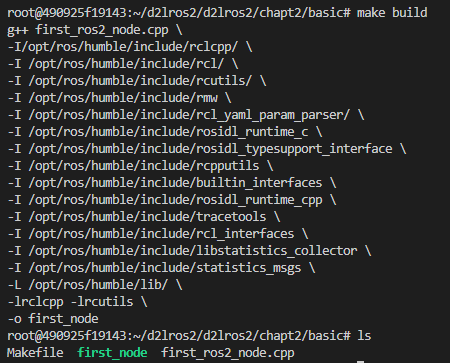
可以看到make指令调用了脚本里的build下的指令,对代码进行了编译。同级目录下也产生了first_node可执行文件(绿色代表可执行)。
使用make clean指令即可删掉first_node节点。

4. 运行测试
./first_node
新开终端
ros2 node list

3.使用CMakeLists.txt编译ROS2节点
虽然通过make调用Makefile编译代码非常的方便,但是还是需要我们手写gcc指令来编译,那有没有什么办法可以自动生成Makefile呢?
答案是有的,那就是cmake工具。
cmake通过调用CMakeLists.txt直接生成Makefile。
1.安装Cmake
sudo apt install cmake
2.新建CMakeLists.txt
在d2lros2/d2lros2/chapt2/basic新建CMakeLists.txt,输入下面内容。
cmake_minimum_required(VERSION 3.22)
project(first_node)
#include_directories 添加特定的头文件搜索路径 ,相当于指定g++编译器的-I参数
include_directories(/opt/ros/humble/include/rclcpp/)
include_directories(/opt/ros/humble/include/rcl/)
include_directories(/opt/ros/humble/include/rcutils/)
include_directories(/opt/ros/humble/include/rcl_yaml_param_parser/)
include_directories(/opt/ros/humble/include/rosidl_runtime_c/)
include_directories(/opt/ros/humble/include/rosidl_typesupport_interface/)
include_directories(/opt/ros/humble/include/rcpputils/)
include_directories(/opt/ros/humble/include/builtin_interfaces/)
include_directories(/opt/ros/humble/include/rmw/)
include_directories(/opt/ros/humble/include/rosidl_runtime_cpp/)
include_directories(/opt/ros/humble/include/tracetools/)
include_directories(/opt/ros/humble/include/rcl_interfaces/)
include_directories(/opt/ros/humble/include/libstatistics_collector/)
include_directories(/opt/ros/humble/include/statistics_msgs/)
# link_directories - 向工程添加多个特定的库文件搜索路径,相当于指定g++编译器的-L参数
link_directories(/opt/ros/humble/lib/)
# add_executable - 生成first_node可执行文件
add_executable(first_node first_ros2_node.cpp)
# target_link_libraries - 为first_node(目标) 添加需要动态链接库,相同于指定g++编译器-l参数
# 下面的语句代替 -lrclcpp -lrcutils
target_link_libraries(first_node rclcpp rcutils)
3.编译代码
我们一般会创建一个新的目录,运行cmake并进行编译,这样的好处是不会显得那么乱。
mkdir build
cd build
创建好文件夹,接着运行cmake指令,..代表到上级目录找CMakeLists.txt。
cmake ..
运行完cmake你应该可以在build目录下看到cmake自动生成的Makefile了,接着就可以运行make指令进行编译
make
运行完上面的指令,就可以在build目录下发现first_node节点了。
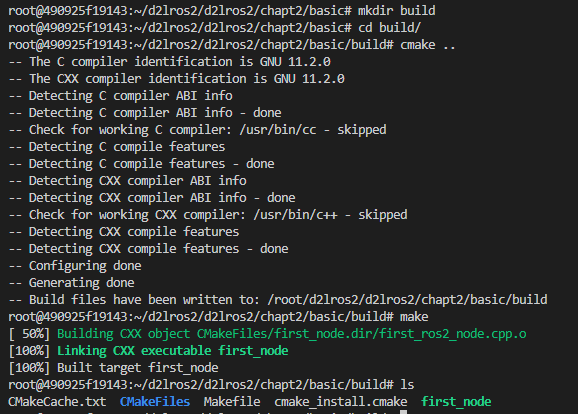
4.CMake依赖查找流程
上面我们用g++、make、cmake三种方式来编译ros2的C++节点。用cmake虽然成功了,但是CMakeLists.txt的内容依然非常的臃肿,我们需要将其进一步的简化。
1.优化CMakeList.txt
将上面的CmakLists.txt改成下面的样子
cmake_minimum_required(VERSION 3.22)
project(first_node)
find_package(rclcpp REQUIRED)
add_executable(first_node first_ros2_node.cpp)
target_link_libraries(first_node rclcpp::rclcpp)
接着继续生成和编译
cmake ..
make
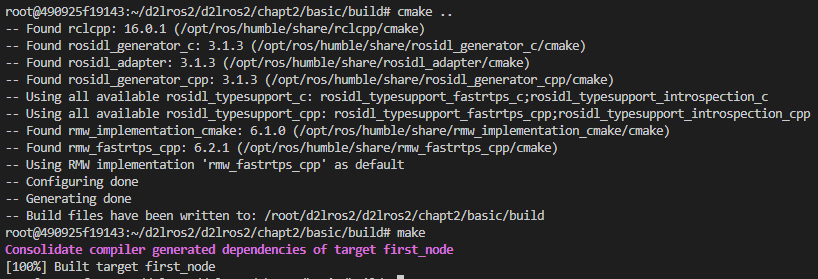
是不是非常的神奇,为什么可以浓缩成那么短的几句指令呢?
2.find_package查找路径
find_package查找路径对应的环境变量如下。
<package>_DIR
CMAKE_PREFIX_PATH
CMAKE_FRAMEWORK_PATH
CMAKE_APPBUNDLE_PATH
PATH
打开终端,输入指令:
echo $PATH
结果
PATH=/opt/ros/humble/bin:/usr/local/sbin:/usr/local/bin:/usr/sbin:/usr/bin:/sbin:/bin
观察PATH变量,你会发现/opt/ros/humble/bin赫然在其中,PATH中的路径如果以bin或sbin结尾,则自动回退到上一级目录,接着检查这些目录下的
<prefix>/(lib/<arch>|lib|share)/cmake/<name>*/ (U)
<prefix>/(lib/<arch>|lib|share)/<name>*/ (U)
<prefix>/(lib/<arch>|lib|share)/<name>*/(cmake|CMake)/ (U)
cmake找到这些目录后,会开始依次找<package>Config.cmake或Find<package>.cmake文件。找到后即可执行该文件并生成相关链接信息。
打开/opt/ros/humble/share/rclcpp/cmake你会发现rclcppConfig.cmake就在其中。
3.总结
本节通过多种方式进行节点的编译,主要是让你了解C++编译工具cmake以及其路径查找规则,以后在学习生涯中再遇到undefined reference to xxxxx和No such file or directory
就再也不用慌张了。